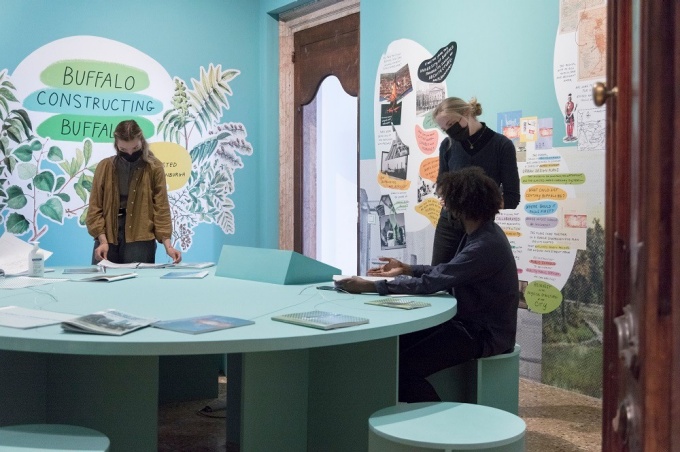Curator's Statement

"Buffalo Constructing Buffalo: From Olmsted to Van Valkenburgh," installed at the Time Space Existence exhibition in Venice's historic Palazzo Mora. Photos by gerda studio.
The following is the official curator's statement for the "Buffalo Constructing Buffalo: From Olmsted to Van Valkenburgh" exhibition at Time Space Existence in Venice, Italy.
Over half a century, faculty and students of the University at Buffalo School of Architecture and Planning (UB) have contributed to Buffalo, New York's continuous construction through hundreds of acts of planning, design, and making. The film we produced and directed for Time Space Existence (2018), See it Through Buffalo, profiled 50 sites of UB engagements in Buffalo, some spanning decade. It was an artful inquiry into UB's relationships with the city that hosts it. The School has led the development of the official planning framework for Buffalo - waterfront, parks, downtown, city, region, and economy. Now it has established the community vision for the next big step in the ongoing construction of Buffalo - the transformation of a waterfront park from a challenging, flat stretch of grass to an enchanting landscape at the eastern tip of Lake Erie.
City-building is a complex, collective, and cumulative process in which many agents, large and small, work together (sometimes at odds) across space and time to construct the common home. The School is an indispensable participant in that process of "Buffalo Constructing Buffalo."
The exhibit interprets the collaborative civic work of creating the park, driven by values defined through public engagement, informed by precedent and analysis of existing conditions, and inspired by an elevation of expectations for the user experience. The park will be linked to a broader system of parks and trails, served by systems of maintenance and operations, and nourished by governance structures that mobilize community support. The project involves the university, city government, and a significant donor with park user groups, neighbors, advocacy organizations, and federal and state agencies.
As it has been known, LaSalle Park is just a few hundred feet from The Front Park, part of Frederick Law Olmsted's city-wide system of parks and parkways. Olmsted defines the gestalt of daily life in Buffalo, just as do the lake and river waterfronts and urban planner Joseph Ellicott's radial and grid street plan. Olmsted's legacy remains central to life in Buffalo. Still, it also exists because of the efforts of civic leaders who brought Olmsted to Buffalo and paid to realize his vision, as well as citizens a century later who mobilized to preserve, restore, and honor his work for public enjoyment.
The project rests on work by many others who came before. A century ago, water covered the place where the park exists, next to the Erie Canal, now an interstate highway. Those who filled that land created the park as much as anyone. Buffalo’s 1916 Col. Ward Pumping Station, more like a cathedral than a public utility, still operates. Over the years, the use of LaSalle Park was heavy, investment in it sparing. Yet it attracted citizens of all stripes: parents and children to its playgrounds, dog walkers, bird-watchers, soccer and baseball leagues, skateboarders, ethnic festivals, concerts, and even late-night partiers. They have used the park, but in a sense, they have made it, too.
The renamed Ralph C. Wilson, Jr. Centennial Park is being designed with the landscape architecture firm Michael Van Valkenburgh Associates. They have proposed an integrated set of elements to include a berm to block noise from the interstate, an inviting new bridge to the neighborhood across the highway, a new choreography of spaces for uses old and new, a sledding hill and meadow, a reinvigorated flora including 2,500 new trees, new ways to meet the water, and a magical new playground for children. Physical construction is set to begin in 2022.
Robert G. Shibley FAIA, FAICP
Professor and Dean
Senior Fellow, UB Regional Institute